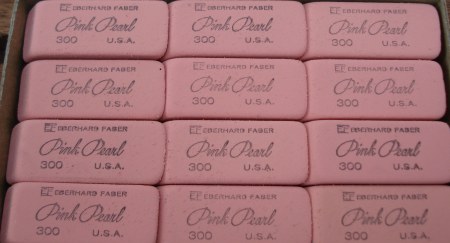
Last week’s eraser test didn’t reveal good results for the Pink Pearl eraser. But the Pink Pearl doesn’t have to worry, because it is more than an eraser. It is a cultural icon.
It is not unlike the pencil in Petroski’s The Pencil – mysterious and undocumented, yet pervasive.
Erasure is about the correction of one’s mistakes – a lofty goal in life. Yet like the Pink Pearl, the effort doesn’t always succeed.
Jason Crane’s portrait of the Pink Pearl pays homage to this cultural instrument. A limited edition of 53, it is a large print that occupies over seven square feet. It could be an inspiration to a writer, visual artist or anyone facing a creative struggle.
Apart from the Dixon Pink Pearl, I have a box of 36 vintage Eberhard Faber Pink Pearls:

They’re cool, but not as cool as Jordan Crane’s print.

Sorry, but I have an irrational, knee-jerk hatred of Pink Pearl erasers. I was once, long ago, a student at the University of Houston architecture school. One of our professors made it abundantly clear that Pink Pearls had no place in our cache of drawing materials. In fact, he said, if he saw the telltale pink smudge of a Pink Pearl eraser on our work, we would be dropped from the program, instantly, with no recourse whatsoever. Did he mean it? Undoubtedly. Could he have followed through with the threat? Maybe. But I was in no position to dispute it. Hence, ever since then, when I see a Pink Pearl eraser, the hairs on my neck rise, and I must get away, quickly.
All of which is not to diss the eraser itself, or anyone who wishes to use it. The above was just one person’s experience, and irrational reaction to it, that’s all.
So—if anyone out there encounters someone with a deep-set loathing of Pink Pearls, my story might explain why. …
CE
Thank you for sharing this reminiscence, which I enjoyed reading!